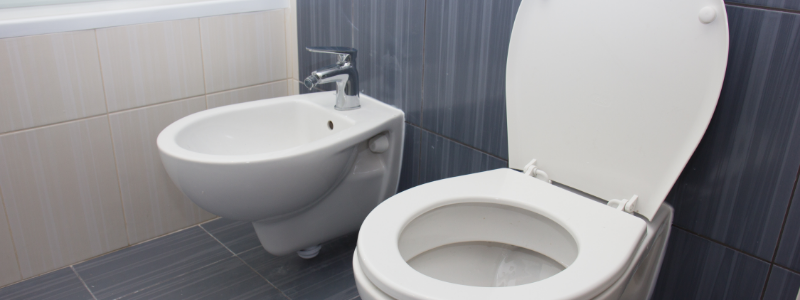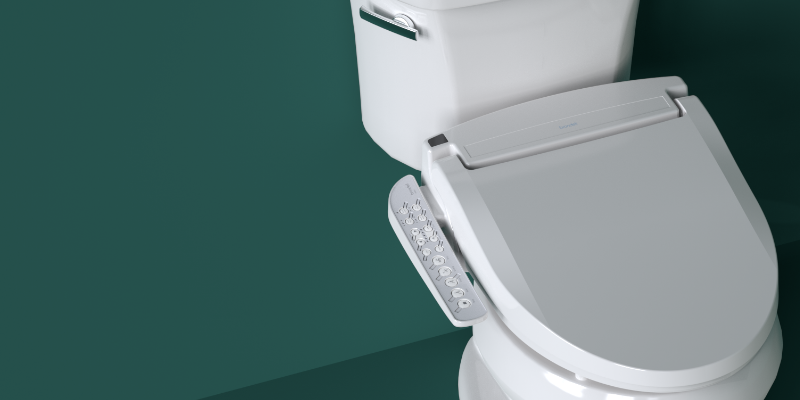What are bidets and bidet toilet seats?

Picture yourself on vacation in Italy in a beautiful rental apartment. Everything about it is stunning—even the bathroom. But one particular device leaves you with more questions than answers: a low, porcelain fixture next to the toilet that looks sort of like an extra sink.
This exotic fixture is known as a standalone bidet. While these were once the only kind of bidet on the market, there are more modern bidets available today. Let’s dig into the different kinds, so you can find the one that’s right for your bathroom.
First off, what is a bidet anyway?
Simply put, a bidet is a bathroom fixture or toilet add-on that provides a refreshing wash after you use the bathroom.
Bidet washes have many benefits, including boosting hygiene and reducing toilet paper waste. Some studies have shown that using a bidet may also help with certain medical issues like hemorrhoids. They may also provide a gentle, hygienic alternative to toilet paper for those who have recently given birth
Bidets are essential to the personal hygiene routines of many cultures—and they’re growing more popular in North America, as well.
What is a standalone bidet?

A standalone bidet is one of those classy, porcelain devices that you may have seen on a trip to Europe.
Unlike more contemporary types of bidets, these individual bathroom fixtures require their own space and plumbing. This makes installing one a bigger, more expensive bathroom project—and most likely requires hiring a plumber.
Besides being costly to install, standalone bidets have another downside: they require you to leave the toilet and walk over to the bidet to wash. For this reason, many prefer bidet add-ons, which attach to your toilet so you can wash without having to get up.
What is a bidet toilet seat?

A bidet toilet seat is exactly what it sounds like—a toilet seat with a bidet built into it.
Installation is pretty straightforward as the bidet simply replaces your old toilet seat. Water from your toilet’s cold water supply flows to the unit through an included plumbing adaptor and bidet hose. That aspect of installation may sound complicated, but really, setup is on par with assembling a piece of furniture that you bought online.
Unlike standalone bidets, bidet toilet seats don’t need their own plumbing, so they’re much cheaper and simpler to install. Another bonus is you can use the bidet while sitting on your toilet. (Standalone bidets require you to walk across the bathroom to wash.)
Bidet toilet seats also have extra features, including warm water washes, heated seats, nightlights, deodorizers, and more.
Note: All of those luxury features do require power. For that reason, bidet toilet seats must be plugged into a GFCI outlet to function.
What are non-electric, add-on bidets?
These are bidets that turn your toilet into a bidet and don’t need electricity to do so.
In general, there are 2 types of bidets in this category: bidet attachments and sprayers. There are a few non-electric bidet toilet seats on the market as well—like our Swash EcoSeat. But in general, most bidet/toilet combos are electronic. In addition to not needing electricity, non-electric bidets are affordable and simple to use and install.
What is a bidet attachment?
Bidet attachments are the most popular type of bidet. These turn your toilet into a bidet by installing underneath your seat.
People love bidet attachments for their hands-free washes. Simply turn a dial on the sidearm, or twist the control handle, to start the bidet wash. Many prefer this process to handheld sprayers, which you have to aim and spray yourself.
Most bidet attachments are ambient temperature, meaning the water you wash with is only as warm as your cold-water supply. If you want warm water washes, some dual-temperature models include the parts you need to hook up to your bathroom’s hot water supply. But your toilet will need to be close enough to that connection—which is usually located under the bathroom sink.
What is a handheld bidet sprayer?

A handheld bidet sprayer (also known as a bidet shower or shattaf) is similar to a kitchen sprayer, except that it’s specifically designed for bidet washes.
To use, simply hold the sprayer in your hand, aim in the desired direction, and start washing. When you’re done, turn off the plumbing adapter (commonly called a T-Valve) and hang the sprayer on the wall or toilet tank in the holster. This is generally included with purchase, along with any other parts you’d need to install.
In addition to boosting hygiene, handheld bidets may be useful for other purposes—like washing the shower walls, bathing pets in the tub, or cleaning cloth diapers.
You are now a bidet expert
Hopefully this guide has helped you understand what a bidet is (and isn’t). The next time you hear someone ask, “what’s a bidet toilet,” you’ll have all the answers. Maybe you’ll even be able to recommend one yourself.
